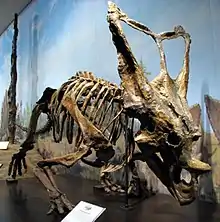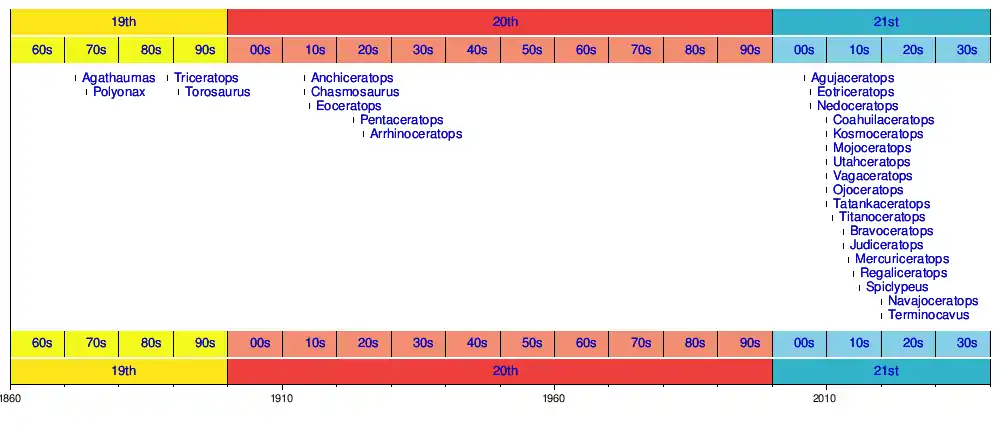Chasmosaurinae
Chasmosaurinae is a subfamily of ceratopsid dinosaurs. They were one of the most successful groups of herbivores of their time. Chasmosaurines appeared in the early Campanian, and became extinct, along with all other non-avian dinosaurs, during the Cretaceous–Paleogene extinction event. Broadly, the most distinguishing features of chasmosaurines are prominent brow horns and long frills lacking long spines; centrosaurines generally had short brow horns and relatively shorter frills, and often had long spines projecting from their frills.
| Chasmosaurines | |
|---|---|
 | |
| Chasmosaurus belli skeleton, Royal Tyrrell Museum of Palaeontology | |
| Scientific classification | |
| Kingdom: | Animalia |
| Phylum: | Chordata |
| Clade: | Dinosauria |
| Order: | †Ornithischia |
| Family: | †Ceratopsidae |
| Subfamily: | †Chasmosaurinae Lambe, 1915 |
| Type species | |
| †Chasmosaurus belli Lambe, 1902 | |
| Subgroups | |
| Synonyms | |
| |
Chasmosaurines evolved in western North America (Laramidia). They are currently known definitively from rocks in western Canada, the western United States, and northern Mexico. They were highly diverse and among the most species-rich groups of dinosaurs, with new species frequently described. This high diversity of named species is likely a result of the frill. The distinctive shape of the frill with the hornlets on its edges (epoccipitals) make it possible to recognize species from incomplete or fragmentary remains.
Classification
Below is the result of a phylogenetic analysis by Mallon et al., following the traditional epiparietal homology scheme from their description of Spiclypeus shipporum. Bravoceratops and Eotriceratops were removed because it was found that they decrease resolution in the analysis because of the authors' new interpretation of epiparietal configurations. Regaliceratops was not resolved as a member of the Triceratopsini.[1]
| Chasmosaurinae |
| |||||||||||||||||||||||||||||||||||||||||||||||||||||||||||||||||||||||||||||||||||||||||||||||||||||||||
Below is the result of a 2020 phylogenetic analysis by Fowler and Freedman Fowler et al. The authors hypothesized that two distinct and roughly contemporary lineages of chasmosaurines existed in the late Cretaceous - a northern Chasmosaurus lineage, in which the frill margin began as heart-shaped and then flattened and curled over onto itself, and a southern Pentaceratops lineage, in which the indentation in the initially heart-shaped frill margin pinched closed. This later lineage may have given rise to the Triceratopsini, as suggested by the cladogram below. As in the Mallon et al. analysis above, some taxa based on incomplete or juvenile remains (Bravoceratops and Agujaceratops) were removed to increase resolution. While a single "Pentaceratops lineage" was not recovered by this revised analysis as they had predicted based on frill shape, the authors speculated that this may be due to some specimens included as Pentaceratops sternbergii being misclassified, and possibly referable to other species pending further study. The authors also noted that some newer species included in the previous analysis by Mallon et al. (Spiclypeus, Regaliceratops, etc.) had yet to be coded into their revised dataset.[2]
| Chasmosaurinae |
| ||||||||||||||||||||||||||||||||||||||||||||||||||||||||||||||||||
Timeline

See also
References
- Jordan C. Mallon, Christopher J. Ott, Peter L. Larson, Edward M. Iuliano and David C. Evans (2016). "Spiclypeus shipporum gen. et sp. nov., a Boldly Audacious New Chasmosaurine Ceratopsid (Dinosauria: Ornithischia) from the Judith River Formation (Upper Cretaceous: Campanian) of Montana, USA". PLoS ONE. 11 (5): e0154218. doi:10.1371/journal.pone.0154218. PMC 4871577. PMID 27191389.CS1 maint: uses authors parameter (link)
- Fowler, Denver W., and Elizabeth A. Freedman Fowler. "Transitional evolutionary forms in chasmosaurine ceratopsid dinosaurs: evidence from the Campanian of New Mexico." PeerJ 8 (2020): e9251. https://peerj.com/articles/9251/
External links
| Wikispecies has information related to Chasmosaurinae. |





